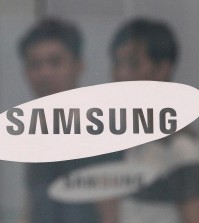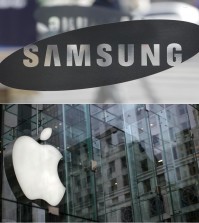- California Assembly OKs highest minimum wage in nation
- S. Korea unveils first graphic cigarette warnings
- US joins with South Korea, Japan in bid to deter North Korea
- LPGA golfer Chun In-gee finally back in action
- S. Korea won’t be top seed in final World Cup qualification round
- US men’s soccer misses 2nd straight Olympics
- US back on track in qualifying with 4-0 win over Guatemala
- High-intensity workout injuries spawn cottage industry
- CDC expands range of Zika mosquitoes into parts of Northeast
- Who knew? ‘The Walking Dead’ is helping families connect
Samsung Electronics heads for first annual profit decline in 3 years
SEOUL (Yonhap) — Samsung Electronics Co., the world’s top maker of smartphones and memory chips, is headed for the first annual profit fall in three years, dragged down by weak smartphone sales amid intensifying competition with global rivals.
The South Korean tech giant in a regulatory filing estimated its operating profit at 5.2 trillion won (US$4.73 billion) for the fourth quarter, dipping 37.4 percent from a year earlier.
Compared with three months ago, however, the figure marks a 28.1 percent increase from the 4.1 trillion-won operating income, the firm’s worst performance since the second quarter of 2011.
While uncertainty persists with dim prospects for its sluggish handset segment, analysts said the visible on-quarter profit jump in the fourth quarter is a signal that the company has most likely bottomed out and is on the way to a moderate recovery this year.
“The company seems to be stabilizing from the third-quarter earnings shock. We could say (Samsung has) bottomed out in performance, at least in a psychological sense,” said Lee Seung-woo, an analyst at IBK Securities Co. before the release of the earnings guidance.
The fourth-quarter guidance beat the median estimate of 4.78 trillion won based on a poll by 26 brokerage houses here compiled by Yonhap Infomax, the financial news arm of Yonhap News Agency.
For all of 2014, the company said its aggregate operating profit likely dipped 32.2 percent on-year to 24.9 trillion won, with the combined revenue estimated at 205.5 trillion won, down 10.2 percent from a year ago.
The final earnings figures are due to be released later this month.
Shares of the tech firm closed up 0.54 percent to 1,314.000 won on Thursday, versus a 1.11 percent gain on the broader KOSPI. The earnings preview was released before the stock market opened.
The big on-quarter jump in profit is in accordance with analysts’ earlier forecast that had bet on a substantial recovery from the stunning decline in the third quarter, during which it logged a 60 percent on-year plunge from the record high of 10.1 trillion won.
Analysts cited better sales in its chip business and a pickup in the smartphone sector as reasons that likely helped the firm gather ground.
IBK Securities Co., a local brokerage firm, predicted the operating profit from memory chips to have soared 23 percent in the fourth quarter from three months earlier on higher demand for mobile DRAMs.
Samsung does not include estimates for net profit and break-down figures for sectoral performance in its earnings previews.
Many analysts shared the view that Samsung’s System LSI sector, which involves making application processors for mobile devices and foundry business, would have likely reduced losses over the cited period, as demand improved and notably on the back of production of the 14-nano FinFET technology.
The 3-dimensional chip that delivers far more power efficiency than planar transistors is the latest technology in the component segment that will likely lure customers away from Taiwanese rival TSMC, the world’s top contract chip maker to which Samsung has lost its biggest client Apple Inc.
In the conference call on the third-quarter earnings, Samsung had said the FinFET process was making good headway and that it had started production of the FinFET-based chips for some customers that Samsung refused to identify, although many have bet that it’s Apple.
Analysts were split in views about returns from the handset division, with some projecting a rebound while others forecast a less steep drop from the previous quarter.
But few disagreed that Samsung’s shift in strategy with smartphones to make more low-tier models — aimed at retaining market share against Chinese upstarts like Xiaomi Inc. — will help arrest the profit decline in the segment.
Samsung has been losing market share of its flagship handset business, which accounts for 70 percent of its revenue, due to sluggish sales of marquee Galaxy models and the fast growth of smaller rivals cranking out cheaper phones.
Its global share, which had reached over 30 percent at one point in 2012, has fallen to 23.7 percent at the end of September last year. Xiaomi became the world’s third-largest smartphone maker over that period.
“The change in strategy will show in the first-quarter (results), since the low-end A and E series were only launched during the last quarter of 2014,” Lee added.
Lee Min-hee, an analyst at I’M Investment & Securities Co., estimated Samsung’s smartphone shipments to have slid to about 77 million units from 78 million units over the three-month period.
Samsung began selling the budget phone lineup Galaxy E7 and E5 in India earlier this month, following the December release of the Galaxy A5 and A3 in China in hopes for recouping its market share.
Analysts bet profits of display and consumer electronics segments to at least double in the same period, thanks to brisk sales of advanced display AMOLED panels and robust seasonal demand for home appliances.
Revenue in the October-December period was estimated at 52.0 trillion won, down 12.3 percent from the previous year, but up 9.6 percent compared with three months earlier, in line with the market consensus of 52.1 trillion won.
Lee of IBK Securities said the increase in revenue is, however, largely attributed to the recent depreciation of the local currency. The Korean won weakened about 6 percent against the U.S. dollar to 1,025 won from 1,085 won on average in the third quarter.
For the 2015 outlook, analysts here gave weight to the fact that Samsung’s semiconductor division is making a considerable turnaround, anticipating the chip business will play a vital role for some time in offsetting the slowdown in smartphone sales.
“Samsung might see returns from memory chips this year eclipse that of mobile phones,” said Lee Se-chul, an analyst at Woori investment & Securities Co. He predicted an annual 12.1 trillion won in operating profit from the chip sector, as opposed to 8.9 trillion won from the handset part.

















